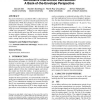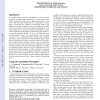336 search results - page 20 / 68 » Centralized Communication in Radio Networks with Strong Inte... |
HOTNETS
2010
13 years 3 months ago
2010
Successive interference cancellation (SIC) is a physical layer capability that allows a receiver to decode packets that arrive simultaneously. While the technique is well known in...
GLOBECOM
2006
IEEE
14 years 2 months ago
2006
IEEE
It is shown in this paper that direct extensions of distributed greedy Interference Avoidance (IA) techniques for networks with centralized receivers to networks with multiple unc...
CORR
2007
Springer
13 years 8 months ago
2007
Springer
—In cognitive radio (CR) networks, there are scenarios where the secondary (lower priority) users intend to communicate with each other by opportunistically utilizing the transmi...
CORR
2008
Springer
13 years 8 months ago
2008
Springer
In wireless sensor networks, bandwidth is one of precious resources to multimedia applications. To get more bandwidth, multipath routing is one appropriate solution provided that ...
TWC
2010
13 years 3 months ago
2010
Abstract-- Relaying and orthogonal frequency division multiple access (OFDMA) are the accepted technologies for emerging wireless communications standards. The activities in many w...


